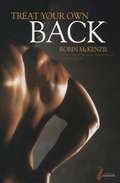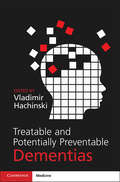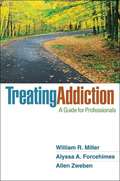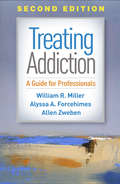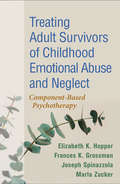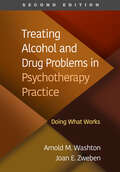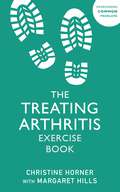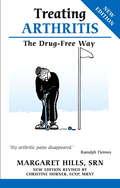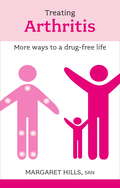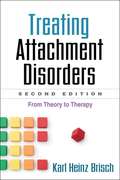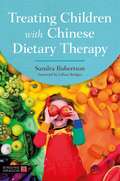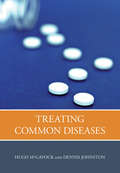- Table View
- List View
Treat Your Own Back
by Robin MckenzieMaintain effective long-term back self-management with Robin McKenzies completely revised and formatted 9th edition landmark patient book. This informative, easy-to-read book contains updated content from Robin McKenzie.
Treatable and Potentially Preventable Dementias
by Vladimir HachinskiThe first comprehensive and authoritative book covering the basis for the joint prevention of stroke and the management, delay, or prevention of some dementias. Engaging with the concept of cerebrovascular disease as asymptomatic, with overwhelming evidence that major dementias involve a vascular component, ranging from 60 per cent in frontotemporal dementia to 80 per cent in Alzheimer disease - doubling the chances of silent brain pathology manifesting as dementia. Beginning with a review of the basics, describing typical patients and presentations and providing clear guidelines in diagnoses, management, and prevention, this vital guide is invaluable for physicians dealing with cognitive impairments, including family physicians, psychiatrists, internists, geriatricians and neurologists, worldwide. This book provides a new, coherent and promising approach, filling the gap between what is known and what is applied, offering a great opportunity for appropriate interventions and treatments that make a difference. Improving outcomes, beginning now.
Treating ADHD and Comorbid Disorders
by Steven Pliszka Larry GreenhillChildren and adolescents with attention-deficit/hyperactivity disorder (ADHD) frequently experience co-occurring problems with aggression, mood swings, tics, anxiety, or depression. Organized around detailed case presentations, this highly informative book helps the clinician make sound decisions when assessing and treating the full range of ADHD comorbidities. Experienced child psychiatrist Steven Pliszka offers straightforward guidance on how to avoid common diagnostic errors, develop an individualized medication regimen, minimize health risks and side effects, collaborate successfully with parents, and tailor psychosocial treatments to each family's needs. A reproducible structured interview facilitates sorting out symptoms and distinguishing between different comorbid disorders.
Treating ADHD in Children and Adolescents: What Every Clinician Needs to Know
by Russell A. BarkleyFrom foremost authority Russell A. Barkley, this book presents essential principles and practices for managing attention-deficit/hyperactivity disorder (ADHD) in children and teens. Barkley interweaves the best scientific knowledge with lessons learned from decades of clinical practice and research. He provides guidelines and clinical tips for conducting thorough, accurate assessments and developing and implementing science-based treatment plans. The book is grounded in Barkley's theory of ADHD as a disorder of executive functioning and self-regulation. Ways to collaborate successfully with parents and other professionals are highlighted throughout. In a convenient large-size format, the volume includes 45 reproducible handouts and forms that can be downloaded and printed for repeated use.
Treating Acne and Rosacea with Chinese Herbal Medicine
by Sabine SchmitzThis practical, fully illustrated handbook is the second in our series on dermatological diseases and their treatment with Chinese herbal medicine by Sabine Schmitz. This volume examines the cause and treatment of acne and rosacea from a Chinese medicine perspective and provides advice for practitioners on their treatments in their daily practice.It covers prescriptions and treatment options for all types of acne, rosacea and TCM syndromes, detailed case studies and colour photographs of the skin and tongue for precise diagnosis. The book also contains instructions on external applications such as pastes, washes or ointments, as well as detailed diet instructions and advice.Easy to read, use and navigate, Treating Acne and Rosacea with Chinese Herbal Medicine is the perfect resource for anyone treating skin diseases in their daily practice, regardless of their specialization.
Treating Addiction
by William R. Miller Alyssa A. Forcehimes Allen ZwebenAn indispensable practitioner reference and text, this engaging book focuses on how to provide effective help to clients with substance use disorders. The authors, leading authorities on addiction treatment, present a state-of-the-art framework for assessment and treatment. They describe and illustrate evidence-based treatment methods, including cognitive-behavioral, 12-step, motivational, pharmacological, and family approaches. Also addressed are such crucial clinical issues as resistance, maintenance of change, treating co-occurring disorders, and spirituality. Reproducible clinical tools can be photocopied from the book or downloaded and printed in a convenient 8 1/2" x 11" size. Of special utility, the companion website features more than 25 widely used, ready-to-download assessment tools, assembled in one place for the first time, together with the authors' guidance for using them throughout the process of treatment.
Treating Addiction
by William MillerAn indispensable practitioner reference and text, this engaging book focuses on how to provide effective help to clients with substance use disorders. The authors, leading authorities on addiction treatment, present a state-of-the-art framework for assessment and treatment. They describe and illustrate evidence-based treatment methods, including cognitive-behavioral, 12-step, motivational, pharmacological, and family approaches. Also addressed are such crucial clinical issues as resistance, maintenance of change, treating co-occurring disorders, and spirituality. Reproducible clinical tools can be photocopied from the book or downloaded and printed in a convenient 8 1/2" x 11" size. Of special utility, the companion Web page features more than 25 widely used, ready-to-download assessment tools, assembled in one place for the first time, together with the authors' guidance for using them throughout the process of treatment.
Treating Addiction, Second Edition: A Guide for Professionals
by William R. Miller Alyssa A. Forcehimes Allen ZwebenThis widely respected text and practitioner guide, now revised and expanded, provides a roadmap for effective clinical practice with clients with substance use disorders. Specialists and nonspecialists alike benefit from the authors' expert guidance for planning treatment and selecting from a menu of evidence-based treatment methods. Assessment and intervention strategies are described in detail, and the importance of the therapeutic relationship is emphasized throughout. Lauded for its clarity and accessibility, the text includes engaging case examples, up-to-date knowledge about specific substances, personal reflections from the authors, application exercises, reflection questions, and end-of-chapter bulleted key points. New to This Edition *Chapters on additional treatment approaches: mindfulness, contingency management, and ways to work with concerned significant others. *Chapters on overcoming treatment roadblocks and implementing evidence-based treatments with integrity. *Covers the new four-process framework for motivational interviewing, diagnostic changes in DSM-5, and advances in pharmacotherapy. *Updated throughout with current research and clinical recommendations.
Treating Adolescent Substance Use: A Clinician's Guide
by Justine W. Welsh Scott E. HadlandClinicians are now facing new substance use-related challenges such as the opioid crisis, a changing political landscape regarding marijuana, and the emergence of new delivery devices such as e-cigarettes. Unfortunately, it is more critical than ever that clinicians caring for adolescents have a proficiency in treating substance use. <p><p> This book is a comprehensive clinical guide that discusses the prevalence of substance use among adolescents and young adults, as well as prevention strategies, available screening methods, practical treatment applications and their outcomes. Using a multidisciplinary approach with inclusion of authors from diverse clinical backgrounds, this definitive guide provides the best practices for treating adolescent substance use disorders from medical, behavioral, and social standpoints. <p> Supplemented with case examples and written by experts in the field, Treating Adolescent Substance Use appeals to all clinicians that treat adolescent patients.
Treating Adolescents with Substance Use Disorders
by Oscar G. BuksteinFrom a leading addiction specialist, this highly practical book explores what works in treating adolescents. Oscar G. Bukstein answers the clinician's vital question: "What do I do now?" He describes best practices for enhancing youths' motivation for change, teaching a variety of recovery skills, and implementing parent management training and parent–adolescent problem solving. The book covers ways to foster a prosocial peer network and to address mental health problems that co-occur with substance use disorders (SUDs). Clinicians can combine the strategies into an integrated approach or pick and choose depending on the needs of individual clients. Reproducible handouts and worksheets can be downloaded and printed in a convenient 8 1/2" x 11" size.
Treating Adult Survivors of Childhood Emotional Abuse and Neglect: Component-Based Psychotherapy
by Christine A. Courtois Bessel A. van der Kolk Elizabeth K. Hopper Frances K. Grossman Joseph Spinazzola Marla ZuckerGrounded in 40 years of clinical practice and research, this book provides a systematic yet flexible evidence-informed framework for treating adult survivors of complex trauma, particularly those exposed to chronic emotional abuse or neglect. Component-based psychotherapy (CBP) addresses four primary treatment components that can be tailored to each client's unique needs--relationship, regulation, dissociative parts, and narrative. Vivid extended case examples illustrate CBP intervention strategies and bring to life both the client's and therapist's internal experiences. The appendix features a reproducible multipage clinician self-assessment tool that can be downloaded and printed in a convenient 8 1/2" x 11" size. See also Treating Traumatic Stress in Children and Adolescents, Second Edition, by Margaret E. Blaustein and Kristine M. Kinniburgh, which presents a complementary approach also developed at The Trauma Center at Justice Resource Institute.
Treating Alcohol and Drug Problems in Psychotherapy Practice: Doing What Works
by Arnold M. Washton Joan E. ZwebenWritten specifically for the office-based psychotherapist, this practical guide describes how to detect, assess, diagnose, and treat clients presenting with a range of alcohol and drug problems. Detailed is an integrated, flexible psychotherapeutic approach that emphasizes building a strong therapeutic relationship, engaging clients "where they are," and addressing substance use within the larger context of their lives. The authors describe in very pragmatic terms how to use a combination of motivational, cognitive-behavioral, 12-step, and psychodynamic techniques with clients in different stages of change. Techniques are brought to life with numerous case vignettes, and appendices include reproducible client forms and handouts
Treating Alcohol and Drug Problems in Psychotherapy Practice: Doing What Works
by Arnold M. Washton Joan E. ZwebenProviding a framework for treating substance use disorders (SUDs) in office-based psychotherapy, the second edition of this trusted work has been updated throughout and features two entirely new chapters. The authors show how clinicians from any background can leverage the therapeutic skills they already have to address clients' alcohol and drug problems competently and effectively. Vivid case examples demonstrate ways to engage clients at different stages of change; set collaborative treatment goals; address SUDs concurrently with other psychological problems; and interweave motivational, cognitive-behavioral, and other interventions, tailored to each individual's needs. Reproducible forms and handouts can be downloaded and printed in a convenient 8 1/2" x 11" size. New to This Edition *Chapter on evidence-based principles and interventions. *Chapter on moderation-focused alcohol treatment. *Revised throughout with current data, clinical techniques, and examples. *Reflects over 15 years of important changes in the field--increased demand for integrated treatment, the ongoing opioid crisis, the growth of harm reduction and medication-assisted treatments, and more.
Treating Arthritis Exercise Book
by Christine HornerMOVE BETTER, FEEL BETTER - TREATING ARTHRITIS THE NATURAL WAYHundreds of thousands of people with arthritis have been helped by the Margaret Hills Clinic and by Margaret's bestselling books, Treating Arthritis: The Drug Free Way and The Treating Arthritis Diet Book. This companion title, completely updated with new exercises, routines and the latest insights into arthritis and joint function, offers a full program to help restore mobility and flexibility for those who are struggling with pain or discomfort. Embracing the simple principles that make the Margaret Hills drug-free protocol so effective, this book will give stepped and manageable exercises that work to improve fitness and function in anyone experiencing inflammation or pain. You don't need to be fit, athletic or flexible to derive benefits from this book, no special equipment is necessary, and you can commit as little (or as much) time as fits your routine. Used in conjunction with the diet and lifestyle management from the companion titles above, you can significantly improve not only your physical condiiton but also your mental and emotional wellbeing.
Treating Arthritis Exercise Book
by Christine HornerMOVE BETTER, FEEL BETTER - TREATING ARTHRITIS THE NATURAL WAYHundreds of thousands of people with arthritis have been helped by the Margaret Hills Clinic and by Margaret's bestselling books, Treating Arthritis: The Drug Free Way and The Treating Arthritis Diet Book. This companion title, completely updated with new exercises, routines and the latest insights into arthritis and joint function, offers a full program to help restore mobility and flexibility for those who are struggling with pain or discomfort. Embracing the simple principles that make the Margaret Hills drug-free protocol so effective, this book will give stepped and manageable exercises that work to improve fitness and function in anyone experiencing inflammation or pain. You don't need to be fit, athletic or flexible to derive benefits from this book, no special equipment is necessary, and you can commit as little (or as much) time as fits your routine. Used in conjunction with the diet and lifestyle management from the companion titles above, you can significantly improve not only your physical condiiton but also your mental and emotional wellbeing.
Treating Arthritis the Drug Free Way: From Protest To Power
by margaret hillsThe Treating Arthritis books draw on more than 25 years of experience at the renowned Margaret Hills clinic, and have helped hundreds of thousands of people with arthritis. The new edition of this book looks at research which suggests that the Margaret Hills programme is effective in treating arthritis, with some patients having impressive improvements after just a few weeks. The link between exceptional stress and arthritis is also explored. Other topics include: pain relief and better mobility; medication and side-effects; improved quality of life; new section on troubleshooting, which considers situations such as joint pain from other health conditions, digestive health, arthritis in later life, arthritis in children and young people, and co-existing conditions such as high blood pressure, depression and weight problems.
Treating Arthritis: The Drug Free Way
by Christine HornerHundreds of thousands of arthritis sufferers have been helped by Margaret Hills and her clinic, and this new edition of her bestselling book will help you, too, whatever the degree or severity of your condition.At the heart of this book are simple, essential principles to help you treat your arthritis by natural means, dramatically improving your levels of pain, mobility and wellbeing. Research has shown that the Margaret Hills Programme can give impressive results after just a few weeks, and that it can bring significant improvements to people even with chronic or severe arthritis. The book reveals the impact of stress on arthritis, while it troubleshoots topics like digestive health, arthritis in childhood, and co-existing conditions.Above all, this book will help you to shift your mindset and develop a more positive approach to your illness - you are not beyond help, but with some simple steps can regain better mobility, less pain and a happier future. Margaret Hills, and the Margaret Hills ClinicAt the age of 21, while training to be a nurse, Margaret Hills developed rheumatoid arthritis literally overnight, resulting in months of complete bed rest to aid her recovery. Years later, after completing her training, she developed osteoarthritis, leading to another attack of rheumatoid arthritis, leaving her crippled and in severe pain. Realising that the medical profession could do nothing for her, as the only available treatment was aspirin, she began to look into natural treatments.Margaret researched many different natural approaches to healing, including traditional remedies such as Epsom Salts baths and Cider Vinegar. She combined these detoxification remedies with a particular combination of nutritional supplements to develop her own treatment. After a year of following this regimen, she rid herself of all signs of arthritis, and continued to lead a pain-free life. The word spread gradually of Margaret Hills' efforts to rid herself of all arthritic symptoms, and many people contacted her to find out more details as so many were in a similar situation of extreme pain due to arthritis of some type. Due to huge public interest, she opened a clinic to help others who were suffering, and to guide others through their recovery. The clinic, now run by her daughter, Christine Horner, continues to attract patients from far and wide and, following on from its success, Margaret wrote this book to impart her knowledge and help people with arthritis everywhere.
Treating Arthritis: The Drug Free Way
by Christine HornerDoctors and consultants may be very surprised when they see patients suffering intractable arthritis suddenly beginning to get better. The medical profession knows all too well that anti-arthritic medication does not have this effect. As the days go by, the improvement often continues so that drugs can be dispensed with, and people lead a normal life. Best-selling author of several books about arthritis, Margaret Hills here tells the amazing stories of people who have benefited from her honey and cider vinegar cure. Advice about diet and stress is also included, so that readers have very real and practical tools to help them treat their arthritis. Crippled herself with arthritis, Margaret Hills used her nurse's training and determination to win back her health. Since then her 'acid-free' approach has brought relief to thousands. Her daughter, Christine Horner, who now runs the Margaret Hills Clinic, continues her work. Topics include: Arthritis in children Arthritis in adults A selection of case histories The stress factor: how it affects the body and contributes to arthritis, and how it can be alleviated.
Treating Arthritis: The Drug Free Way
by Margaret HillsDoctors and consultants may be very surprised when they see patients suffering intractable arthritis suddenly beginning to get better. The medical profession knows all too well that anti-arthritic medication does not have this effect. As the days go by, the improvement often continues so that drugs can be dispensed with, and people lead a normal life. Best-selling author of several books about arthritis, Margaret Hills here tells the amazing stories of people who have benefited from her honey and cider vinegar cure. Advice about diet and stress is also included, so that readers have very real and practical tools to help them treat their arthritis. Crippled herself with arthritis, Margaret Hills used her nurse's training and determination to win back her health. Since then her 'acid-free' approach has brought relief to thousands. Her daughter, Christine Horner, who now runs the Margaret Hills Clinic, continues her work. Topics include: Arthritis in children Arthritis in adults A selection of case histories The stress factor: how it affects the body and contributes to arthritis, and how it can be alleviated.
Treating Attachment Disorders, Second Edition
by Karl Heinz Brisch Kenneth KronenbergOrganized around extended case illustrations-and grounded in cutting-edge theory and research-this highly regarded book shows how an attachment perspective can inform psychotherapeutic practice with patients of all ages. Karl Heinz Brisch explores the links between early experiences of separation, loss, and trauma and a range of psychological, behavioral, and psychosomatic problems. He demonstrates the basic techniques of attachment-based assessment and intervention, emphasizing the healing power of the therapeutic relationship. With a primary focus on treating infants and young children and their caregivers, the book discusses applications of attachment-based psychotherapy over the entire life course. New to This Edition Incorporates advances in research on neurobiology, genetics, and psychotraumatology. Expanded with a section on inpatient treatment for traumatized children, including in-depth cases. Describes two promising prevention programs for expectant couples, families, and young children. The latest knowledge on disorganized attachment, attachment disorders, and assessments.
Treating Body, Mind and Soul: Alternative Solutions for Modern Living
by Jan de VriesShortly after the success of his autobiography A STEP AT A TIME, many readers asked Jan de Vries for more information regarding his 45 years of experience in the practice of naturopathy.In TREATING BODY, MIND AND SOUL, Jan shares with his readers the many ways in which he treats his patients and details the more extraordinary cases that he has dealt with over the years. In doing so, he provides a clear idea of how the body really works and what physical problems can occur. He also illustrates how some unusual cases have been dealt with successfully in an unorthodox way using complementary therapies. Some of the astounding cases mentioned in his autobiography are dealt with in this book more explicitly to show the way de Vries sees the body as a whole and how, with some small adjustments, he has brought many people newfound health and happiness. Treating people with mental and emotional health problems is a major aspect of Jan's work and over the years he has developed various alternative methods that compliment orthodox treatments. This book reveals intriguingly his success in treating problems of the mind using breathing exercises, homeopathic and herbal remedies as well as cranial osteopathy and acupuncture. Jan also delves into the mystery of the soul and shares his thoughts and theories on why it is entwined so fully with the body and mind. He opines on the twenty-first century diseases that are so often misunderstood and, in many cases, go unidentified and gives tips on how to deal with them.
Treating Childhood Depression with Contextual Emotion Regulation Therapy
by Maria KovacsThis book is the authoritative presentation of contextual emotion regulation therapy (CERT), an innovative intervention expressly designed for depressed children ages 7–13 and their parents. CERT is grounded in decades of research on the development of emotion regulation and on "mood repair" difficulties as a risk factor for clinical depression. Step by step, Maria Kovacs describes ways to teach children skills to modulate feelings of sadness and distress and break the hold of depression symptoms. Extensive therapist, parent, and child exchanges illustrate key treatment principles. Clinicians learn how to structure CERT sessions and implement personalized social–interpersonal, cognitive, behavioral, problem-solving, and psychoeducational interventions. Reproducible tools in the appendices--including forms, posters, and a parent manual--can be downloaded and printed in a convenient 8 1/2" x 11" size.
Treating Children with Chinese Dietary Therapy
by Sandra RobertsonChinese Dietary Therapy is one of the pillars of Chinese medicine and has a large role to play in health. This comprehensive book allows practitioners to add this important element to their paediatric practice and to advise parents on positive food choices for their children. With childhood allergies, asthma, ADHD, obesity and childhood diabetes on the rise, this indispensable resource provides advice on using food as medicine for particular common ailments - such as chronic coughs, colds, stomach aches and constipation. It describes how to use food to prevent illness in children and for long-term health benefits, with a focus on strengthening digestion for a resilient immune system. It also demonstrates how diet can bring the body closer to a state of balance by living in accordance with seasons and the world around us, and listening to the body's intuitions.Focusing on the pivotal role of digestion in a resilient and better immune system for optimal health, Treating Children with Chinese Dietary Therapy gives practitioners of Chinese medicine a resource to bring this ancient awareness to today's parents.
Treating Common Diseases: An Introduction to the Study of Medicine (Radcliffe Ser.)
by Hugh McGavock Dennis Johnston Tony Lockett'The study of disease and its treatment is a life-long intellectual journey which has engaged some of humankind's finest minds and kindest hearts. We are still on that fascinating voyage. Every journey begins with a single step, and that step is the purpose of this book. It is short enough to be read from cover to cover, re-read, studied and learnt. Those who do that should find that they understand much that they encounter in patients, whether in the wards, outpatients or in primary care. [It] should also ease the student clinician's passage to more comprehensive texts, which can be intimidating in their volume and complexity, if there has been no prior introduction.' - Hugh McGavock and Denis Johnston, in the Preface. The study of disease and its treatment is a life-long intellectual journey which has engaged some of humankind's finest minds and kindest hearts. We, the authors, are still on that fascinating voyage. Every journey begins with a single step, and that step is the purpose of this book. It is short enough to be read from cover to cover, re-read, studied and learnt...This concise and practical introduction to the vast and complex subject of medical treatment is jargon-free and easy to read. It aids in the understanding of everyday situations on the wards, in out-patient clinics and in the primary care setting. The handy format is ideal as a ready reference along with its companion volume "How Drugs Work, Second Edition", by Hugh McGavock. It is highly recommended as an undergraduate textbook for students of nursing and medicine, especially those embarking on clinical training, and is also useful for Nurse Practitioners. Primary care nurses with diagnosis and treatment responsibilities will find the guidance invaluable.
Treating Comorbid Opioid Use Disorder in Chronic Pain
by Annette M. Matthews Jonathan C. FellersThis in-depth text addresseshow to approach and treat the chronic pain patient struggling with problematicopioid use. It discusses the approach for patients who may be at highrisk of problematic use, such as those with a history of mental illness orsubstance use disorder. The first part covers diagnosis and treatment, focusingon common best practices that practitioners can adapt to any practice. Two ofthe chapters detail alternative and replacement therapies for opioid. Two morecover special issues in the treatment of women and older patients. Thesecond part reviews the ethical, legal, regulatory, and policy issuessurrounding the treatment of patients with comorbid pain and addiction. Thebook includes strategies for documentation that mitigate the risk of legalissues or ethical boundary crossings. The last part of the book addressestreating comorbid pain and opioid use disorder in different medical settings and thetreatment of co-occurring mental illnesses and substance abuse. Treating Comorbid Opioid Use Disorder in ChronicPain is of great value to psychiatrists, painphysicians, primary care providers, social workers, drug rehabilitationcenters, and other behavioral health professionals.
